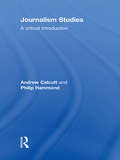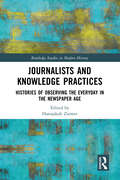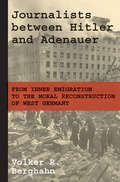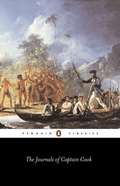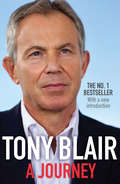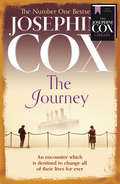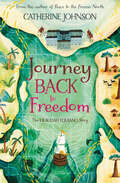- Table View
- List View
Journalism Studies: A Critical Introduction
by Andrew Calcutt Philip HammondAs the world of politics and public affairs has gradually changed beyond recognition over the past two decades, journalism too has been transformed... yet the study of news and journalism often seems stuck with ideas and debates which have lost much of their critical purchase. Journalism is at a crossroads: it needs to reaffirm core values and rediscover key activities, almost certainly in new forms, or it risks losing its distinctive character as well as its commercial basis. Journalism Studies is a polemical textbook that rethinks the field of journalism studies for the contemporary era. Organised around three central themes – ownership, objectivity and the public – Journalism Studies addresses the contexts in which journalism is produced, practised and disseminated. It outlines key issues and debates, reviewing established lines of critique in relation to the state of contemporary journalism, then offering alternative ways of approaching these issues, seeking to reconceptualise them in order to suggest an agenda for change and development in both journalism studies and journalism itself. Journalism Studies is a concise and accessible introduction to contemporary journalism studies, and will be highly useful to undergraduate and postgraduate students on a range of Journalism, Media and Communications courses.
Journalists and Knowledge Practices: Histories of Observing the Everyday in the Newspaper Age (Routledge Studies in Modern History)
by Hansjakob ZiemerThis multi-disciplinary anthology provides new perspectives on the journalist’s role in knowledge generation in the newspaper age—covering diverse topics from fake news to new technologies. Fake news, journalistic authority, and the introduction of cutting-edge technologies are often viewed as new topics in journalism. However, these issues were prevalent long before the twenty-first century. Connecting for the first time two burgeoning strands of research—a newly perceived history of knowledge and the study of journalism—Journalists and Knowledge Practices provides insights into the journalist’s role in the world of knowledge in the newspaper age (ca. 1860s to 1970s). This multi-disciplinary anthology asks how journalists conducted their work and reconstructs histories of journalistic practices in specific regional constellations in Europe and North America. From fake news writing to inventing psychological concepts, integrating electric telegrams to fabricating photographs, explaining pandemics to creating communities, these case studies written by distinguished scholars from various disciplines in the humanities show how notions of fact and truth were shaped, new technologies integrated, and knowledge transfers arranged. This book is crucial reading for scholars and students interested in the historically changing relationships between journalistic practices and the generation and dissemination of knowledge. This volume is crucial reading for scholars and students interested in the history of journalistic practice.
Journalists and Knowledge Practices: Histories of Observing the Everyday in the Newspaper Age (Routledge Studies in Modern History)
by Hansjakob ZiemerThis multi-disciplinary anthology provides new perspectives on the journalist’s role in knowledge generation in the newspaper age—covering diverse topics from fake news to new technologies. Fake news, journalistic authority, and the introduction of cutting-edge technologies are often viewed as new topics in journalism. However, these issues were prevalent long before the twenty-first century. Connecting for the first time two burgeoning strands of research—a newly perceived history of knowledge and the study of journalism—Journalists and Knowledge Practices provides insights into the journalist’s role in the world of knowledge in the newspaper age (ca. 1860s to 1970s). This multi-disciplinary anthology asks how journalists conducted their work and reconstructs histories of journalistic practices in specific regional constellations in Europe and North America. From fake news writing to inventing psychological concepts, integrating electric telegrams to fabricating photographs, explaining pandemics to creating communities, these case studies written by distinguished scholars from various disciplines in the humanities show how notions of fact and truth were shaped, new technologies integrated, and knowledge transfers arranged. This book is crucial reading for scholars and students interested in the historically changing relationships between journalistic practices and the generation and dissemination of knowledge. This volume is crucial reading for scholars and students interested in the history of journalistic practice.
The Journalists and the July Revolution in France: The Role of the Political Press in the Overthrow of the Bourbon Restoration 1827–1830
by Daniel L. RaderThe "July Revolution" of 1830 in France overthrew the King, brought down the Bourbon dynasty, and ended the fifteen-year era known as the Restoration. lt established the "July Monarchy" of Louis-Philippe, citizen King of the Hause of Orleans, a regime also destined for extinction eighteen years later. Although the 1848 revolt is of somewhat greater domestic political importance and considerably greater in its European scope and its social implications, the July Revolution of 1830 should not be relegated to the lower Ievels of historical consciousness. Yet, in modern times, even in France, relatively few works have been published concerning either the Restoration or the revolution which terminated it. New interpretations, such as the excellent works of Bertier de Sauvigny and David Pinkney have awakened the enthusiasm of scholars; but in general, the intrinsic importance of this period has been slighted for nearly a century. There are reasons for this inattention: At first glance, the era seems retrograde, born of a conservative reaction; and placid - it falls between Napoleon's giant earthquake on one side, and on the other, the dynamics of European nationalism, imperialism, and the class struggle. But the Restoration was neither archaic nor calm. lt was, for all its manifest anachronisms, an age of rapid political, cultural, and social growth. France, during these years, was maturing and ripening toward nationhood - and toward the collision of many complex forces, culminating in revolution.
The Journalists and the July Revolution in France: The Role of the Political Press in the Overthrow of the Bourbon Restoration, 1827–1830
by D.L. RaderJournalists between Hitler and Adenauer: From Inner Emigration to the Moral Reconstruction of West Germany
by Volker R. BerghahnThe moral and political role of German journalists before, during, and after the Nazi dictatorshipJournalists between Hitler and Adenauer takes an in-depth look at German journalism from the late Weimar period through the postwar decades. Illuminating the roles played by journalists in the media metropolis of Hamburg, Volker Berghahn focuses on the lives and work of three remarkable individuals: Marion Countess Dönhoff, distinguished editor of Die Zeit; Paul Sethe, “the grand old man of West German journalism”; and Hans Zehrer, editor in chief of Die Welt.All born before 1914, Dönhoff, Sethe, and Zehrer witnessed the Weimar Republic’s end and opposed Hitler. When the latter seized power in 1933, they were, like their fellow Germans, confronted with the difficult choice of entering exile, becoming part of the active resistance, or joining the Nazi Party. Instead, they followed a fourth path—“inner emigration”—psychologically distancing themselves from the regime, their writing falling into a gray zone between grudging collaboration and active resistance. During the war, Dönhoff and Sethe had links to the 1944 conspiracy to kill Hitler, while Zehrer remained out of sight on a North Sea island. In the decades after 1945, all three became major figures in the West German media. Berghahn considers how these journalists and those who chose inner emigration interpreted Germany’s horrific past and how they helped to morally and politically shape the reconstruction of the country.With fresh archival materials, Journalists between Hitler and Adenauer sheds essential light on the influential position of the German media in the mid-twentieth century and raises questions about modern journalism that remain topical today.
Journalists between Hitler and Adenauer: From Inner Emigration to the Moral Reconstruction of West Germany
by Volker R. BerghahnThe moral and political role of German journalists before, during, and after the Nazi dictatorshipJournalists between Hitler and Adenauer takes an in-depth look at German journalism from the late Weimar period through the postwar decades. Illuminating the roles played by journalists in the media metropolis of Hamburg, Volker Berghahn focuses on the lives and work of three remarkable individuals: Marion Countess Dönhoff, distinguished editor of Die Zeit; Paul Sethe, “the grand old man of West German journalism”; and Hans Zehrer, editor in chief of Die Welt.All born before 1914, Dönhoff, Sethe, and Zehrer witnessed the Weimar Republic’s end and opposed Hitler. When the latter seized power in 1933, they were, like their fellow Germans, confronted with the difficult choice of entering exile, becoming part of the active resistance, or joining the Nazi Party. Instead, they followed a fourth path—“inner emigration”—psychologically distancing themselves from the regime, their writing falling into a gray zone between grudging collaboration and active resistance. During the war, Dönhoff and Sethe had links to the 1944 conspiracy to kill Hitler, while Zehrer remained out of sight on a North Sea island. In the decades after 1945, all three became major figures in the West German media. Berghahn considers how these journalists and those who chose inner emigration interpreted Germany’s horrific past and how they helped to morally and politically shape the reconstruction of the country.With fresh archival materials, Journalists between Hitler and Adenauer sheds essential light on the influential position of the German media in the mid-twentieth century and raises questions about modern journalism that remain topical today.
Journalists in Film: Heroes and Villains
by Brian McNairA study of the representation of journalists on film and what this tells us about society's relationship with journalism and news media.
The Journals of Captain Cook: Made In H. M. Bark Endeavour 1768-71 - Primary Source Edition (Penguin Classics)
by Philip Edwards Captain James CookCook led three famous expeditions to the Pacific Ocean between 1768 and 1779. In voyages that ranged from the Antarctic circle to the Arctic Sea, Cook charted Australia and the whole coast of New Zealand, and brought back detailed descriptions of the natural history of the Pacific. Accounts based on Cook's journals were issued at the time, but it was not until this century that the original journals were published in Beaglehole's definitive edition. The JOURNALS tells the story of these voyages as Cook wanted it to be told, radiating the ambition, courage and skill which enabled him to carry out an unrivalled series of expeditions in dangerous waters.
The Journals of Captain James Cook on his Voyages of Discovery: Volume II: The Voyage of the Resolution and Adventure 1772-1775 (Hakluyt Society, Extra Series)
by J.C. BeagleholeCaptain James Cook’s first two voyages of exploration, in 1768-71 and 1772-75, had drawn the modern map of the South Pacific Ocean and had opened the door on the discovery of Antarctica. These expeditions were the subject of Volumes I and II of Dr J.C. Beaglehole’s edition of Cook’s Journals. The third voyage, on which Cook sailed in 1776, was directed to the Northern Hemisphere. Its objective was the discovery of ’a Northern Passage by sea from the Pacific to the Atlantic Ocean’ - the North-west Passage, sought since the 16th century, which would have transformed the pattern of world trade. The search was to take Cook into high latitudes where, as in the Antarctic, his skill in ice navigation was tested. Sailing north from Tahiti in 1778, Cook made the first recorded discovery of the Hawaiian Islands. On March 7 he sighted the Oregon coast in 44° N. The remarkable voyage which he made northward along the Canadian and Alaskan coasts and through Bering Strait to his farthest north in 70° nearly disproved the existence of a navigable passage towards the Atlantic and produced charts of impressive accuracy. Returning to Hawaii to refit, Cook met his death in a clash with the natives as tragic as it seems unnecessary. Dr Beaglehole discusses, with sympathy and insight, the tensions which led Cook, by then a tired man, into miscalculations alien to his own nature and habits. The volume and vitality of the records, both textual and graphic, for this voyage surpass those even for Cook’s second voyage. The surgeons William Anderson and David Samwell, both admirable observers, left journals which are also here printed in full for the first time. The documentation is completed, as in the previous volumes, by appendixes of documents and correspondence and by reproductions of original drawings and paintings mainly by John Webber, the artist of the expedition. In Dr Beaglehole’s words, ’no one can study attentively the records of Cook’s third, and last, v
The Journals of Captain James Cook on his Voyages of Discovery: Volume III, Part I: The Voyage of the Resolution and Discovery 1776-1780 (Hakluyt Society, Extra Series)
by J.C. BeagleholeCaptain James Cook’s first two voyages of exploration, in 1768-71 and 1772-75, had drawn the modern map of the South Pacific Ocean and had opened the door on the discovery of Antarctica. These expeditions were the subject of Volumes I and II of Dr J.C. Beaglehole’s edition of Cook’s Journals. The third voyage, on which Cook sailed in 1776, was directed to the Northern Hemisphere. Its objective was the discovery of ’a Northern Passage by sea from the Pacific to the Atlantic Ocean’ - the North-west Passage, sought since the 16th century, which would have transformed the pattern of world trade. The search was to take Cook into high latitudes where, as in the Antarctic, his skill in ice navigation was tested. Sailing north from Tahiti in 1778, Cook made the first recorded discovery of the Hawaiian Islands. On March 7 he sighted the Oregon coast in 44° N. The remarkable voyage which he made northward along the Canadian and Alaskan coasts and through Bering Strait to his farthest north in 70° nearly disproved the existence of a navigable passage towards the Atlantic and produced charts of impressive accuracy. Returning to Hawaii to refit, Cook met his death in a clash with the natives as tragic as it seems unnecessary. Dr Beaglehole discusses, with sympathy and insight, the tensions which led Cook, by then a tired man, into miscalculations alien to his own nature and habits. The volume and vitality of the records, both textual and graphic, for this voyage surpass those even for Cook’s second voyage. The surgeons William Anderson and David Samwell, both admirable observers, left journals which are also here printed in full for the first time. The documentation is completed, as in the previous volumes, by appendixes of documents and correspondence and by reproductions of original drawings and paintings mainly by John Webber, the artist of the expedition. In Dr Beaglehole’s words, ’no one can study attentively the records of Cook’s third, and last, v
The Journals of Captain James Cook on his Voyages of Discovery: Volume III, Part 2: The Voyage of the Resolution and Discovery 1776-1780
by J.C. BeagleholeCaptain James Cook’s first two voyages of exploration, in 1768-71 and 1772-75, had drawn the modern map of the South Pacific Ocean and had opened the door on the discovery of Antarctica. These expeditions were the subject of Volumes I and II of Dr J.C. Beaglehole’s edition of Cook’s Journals. The third voyage, on which Cook sailed in 1776, was directed to the Northern Hemisphere. Its objective was the discovery of ’a Northern Passage by sea from the Pacific to the Atlantic Ocean’ - the North-west Passage, sought since the 16th century, which would have transformed the pattern of world trade. The search was to take Cook into high latitudes where, as in the Antarctic, his skill in ice navigation was tested. Sailing north from Tahiti in 1778, Cook made the first recorded discovery of the Hawaiian Islands. On March 7 he sighted the Oregon coast in 44° N. The remarkable voyage which he made northward along the Canadian and Alaskan coasts and through Bering Strait to his farthest north in 70° nearly disproved the existence of a navigable passage towards the Atlantic and produced charts of impressive accuracy. Returning to Hawaii to refit, Cook met his death in a clash with the natives as tragic as it seems unnecessary. Dr Beaglehole discusses, with sympathy and insight, the tensions which led Cook, by then a tired man, into miscalculations alien to his own nature and habits. The volume and vitality of the records, both textual and graphic, for this voyage surpass those even for Cook’s second voyage. The surgeons William Anderson and David Samwell, both admirable observers, left journals which are also here printed in full for the first time. The documentation is completed, as in the previous volumes, by appendixes of documents and correspondence and by reproductions of original drawings and paintings mainly by John Webber, the artist of the expedition. In Dr Beaglehole’s words, ’no one can study attentively the records of Cook’s third, and last, v
The Journals of Captain James Cook on his Voyages of Discovery: Volume II: The Voyage of the Resolution and Adventure 1772-1775 (Hakluyt Society, Extra Series)
by J.C. BeagleholeCaptain James Cook’s first two voyages of exploration, in 1768-71 and 1772-75, had drawn the modern map of the South Pacific Ocean and had opened the door on the discovery of Antarctica. These expeditions were the subject of Volumes I and II of Dr J.C. Beaglehole’s edition of Cook’s Journals. The third voyage, on which Cook sailed in 1776, was directed to the Northern Hemisphere. Its objective was the discovery of ’a Northern Passage by sea from the Pacific to the Atlantic Ocean’ - the North-west Passage, sought since the 16th century, which would have transformed the pattern of world trade. The search was to take Cook into high latitudes where, as in the Antarctic, his skill in ice navigation was tested. Sailing north from Tahiti in 1778, Cook made the first recorded discovery of the Hawaiian Islands. On March 7 he sighted the Oregon coast in 44° N. The remarkable voyage which he made northward along the Canadian and Alaskan coasts and through Bering Strait to his farthest north in 70° nearly disproved the existence of a navigable passage towards the Atlantic and produced charts of impressive accuracy. Returning to Hawaii to refit, Cook met his death in a clash with the natives as tragic as it seems unnecessary. Dr Beaglehole discusses, with sympathy and insight, the tensions which led Cook, by then a tired man, into miscalculations alien to his own nature and habits. The volume and vitality of the records, both textual and graphic, for this voyage surpass those even for Cook’s second voyage. The surgeons William Anderson and David Samwell, both admirable observers, left journals which are also here printed in full for the first time. The documentation is completed, as in the previous volumes, by appendixes of documents and correspondence and by reproductions of original drawings and paintings mainly by John Webber, the artist of the expedition. In Dr Beaglehole’s words, ’no one can study attentively the records of Cook’s third, and last, v
The Journals of Captain James Cook on his Voyages of Discovery: Volume III, Part I: The Voyage of the Resolution and Discovery 1776-1780 (Hakluyt Society, Extra Series)
by J.C. BeagleholeCaptain James Cook’s first two voyages of exploration, in 1768-71 and 1772-75, had drawn the modern map of the South Pacific Ocean and had opened the door on the discovery of Antarctica. These expeditions were the subject of Volumes I and II of Dr J.C. Beaglehole’s edition of Cook’s Journals. The third voyage, on which Cook sailed in 1776, was directed to the Northern Hemisphere. Its objective was the discovery of ’a Northern Passage by sea from the Pacific to the Atlantic Ocean’ - the North-west Passage, sought since the 16th century, which would have transformed the pattern of world trade. The search was to take Cook into high latitudes where, as in the Antarctic, his skill in ice navigation was tested. Sailing north from Tahiti in 1778, Cook made the first recorded discovery of the Hawaiian Islands. On March 7 he sighted the Oregon coast in 44° N. The remarkable voyage which he made northward along the Canadian and Alaskan coasts and through Bering Strait to his farthest north in 70° nearly disproved the existence of a navigable passage towards the Atlantic and produced charts of impressive accuracy. Returning to Hawaii to refit, Cook met his death in a clash with the natives as tragic as it seems unnecessary. Dr Beaglehole discusses, with sympathy and insight, the tensions which led Cook, by then a tired man, into miscalculations alien to his own nature and habits. The volume and vitality of the records, both textual and graphic, for this voyage surpass those even for Cook’s second voyage. The surgeons William Anderson and David Samwell, both admirable observers, left journals which are also here printed in full for the first time. The documentation is completed, as in the previous volumes, by appendixes of documents and correspondence and by reproductions of original drawings and paintings mainly by John Webber, the artist of the expedition. In Dr Beaglehole’s words, ’no one can study attentively the records of Cook’s third, and last, v
The Journals of Thomas Babington Macaulay (The Pickering Masters)
by William ThomasPresents the candid diary of Thomas Macaulay, Victorian statesman, historian and author of "The History of England". This work shows how, spanning the period 1838 to 1859, the journal is the longest work from Macaulay's pen. It states that these unique manuscripts held at Trinity College, Cambridge, are most revealing of all his writings.
The Journals of Thomas Babington Macaulay Vol 1
by William ThomasPresents the candid diary of Thomas Macaulay, Victorian statesman, historian and author of "The History of England". This work shows how, spanning the period 1838 to 1859, the journal is the longest work from Macaulay's pen. It states that these unique manuscripts held at Trinity College, Cambridge, are most revealing of all his writings. Volume 1 includes an Introduction and entries for 20 October 1838–12 June 1840.
The Journals of Thomas Babington Macaulay Vol 1 (The\pickering Masters Ser.)
by William ThomasPresents the candid diary of Thomas Macaulay, Victorian statesman, historian and author of "The History of England". This work shows how, spanning the period 1838 to 1859, the journal is the longest work from Macaulay's pen. It states that these unique manuscripts held at Trinity College, Cambridge, are most revealing of all his writings. Volume 1 includes an Introduction and entries for 20 October 1838–12 June 1840.
The Journals of Thomas Babington Macaulay Vol 3
by William ThomasPresents the candid diary of Thomas Macaulay, Victorian statesman, historian and author of "The History of England". This work shows how, spanning the period 1838 to 1859, the journal is the longest work from Macaulay's pen. It states that these unique manuscripts held at Trinity College, Cambridge, are most revealing of all his writings. Volume 3 includes entries for 28 July 1850–4 December 1852.
The Journals of Thomas Babington Macaulay Vol 3 (The\pickering Masters Ser.)
by William ThomasPresents the candid diary of Thomas Macaulay, Victorian statesman, historian and author of "The History of England". This work shows how, spanning the period 1838 to 1859, the journal is the longest work from Macaulay's pen. It states that these unique manuscripts held at Trinity College, Cambridge, are most revealing of all his writings. Volume 3 includes entries for 28 July 1850–4 December 1852.
The Journals of Two Poor Dissenters (Routledge Revivals)
by Guida SwanThe Journals of Two Poor Dissenters (1970) is a remarkable example of voices from the past, giving a humble man’s record of his time. William Swan and his son were Nonconformist labourers in London in the early part of the nineteenth century. They were poor, ill, afflicted with family troubles and the constant problem of finding work. In spite of this they thanked God for each misfortune as it arrived, and looked to the next year with gratitude for all the graces which the modern reader may find hard to detect. The Introduction places this account in its context of history and social record.
The Journals of Two Poor Dissenters (Routledge Revivals)
The Journals of Two Poor Dissenters (1970) is a remarkable example of voices from the past, giving a humble man’s record of his time. William Swan and his son were Nonconformist labourers in London in the early part of the nineteenth century. They were poor, ill, afflicted with family troubles and the constant problem of finding work. In spite of this they thanked God for each misfortune as it arrived, and looked to the next year with gratitude for all the graces which the modern reader may find hard to detect. The Introduction places this account in its context of history and social record.
A Journey: My Political Life
by Tony BlairIn 1997, Tony Blair won the biggest Labour victory in history to sweep the party to power and end eighteen years of Conservative government. He has been one of the most dynamic leaders of modern times; few British prime ministers have shaped the nation's course as profoundly as Blair during his ten years in power, and his achievements and his legacy will be debated for years to come. Now his memoirs reveal in intimate detail this unique political and personal journey, providing an insight into the man, the politician and the statesman, and charting successes, controversies and disappointments with an extraordinary candour. A Journey will prove essential and compulsive reading for anyone who wants to understand the complexities of our global world. As an account of the nature and uses of power, it will also have a readership that extends well beyond politics, to all those who want to understand the challenges of leadership today.
The Journey
by Josephine CoxThis bestseller from the country’s number one storyteller is a deeply moving and powerful tale of love and courage.
The Journey After the Crown
by Andrew Mackie‘If you’re a fan of The Crown, Bridgerton and Downton Abbey that this book will not disappoint. This book will have you gasp, laugh and cry. Not one to be missed!’ NetGalley reviewer, ⭐⭐⭐⭐⭐ A young Queen. Two sisters. A voyage that will change their fates forever.
Journey Back to Freedom: The Olaudah Equiano Story
by Catherine JohnsonFrom the horrors of the slave trade to a book that changed the world, Catherine Johnson celebrates the incredible life of Olaudah Equiano in this gripping true story.
